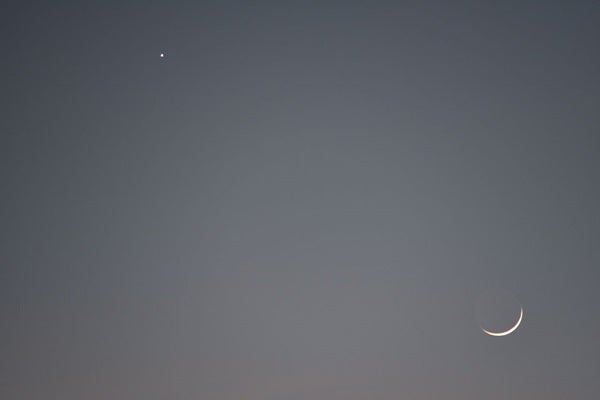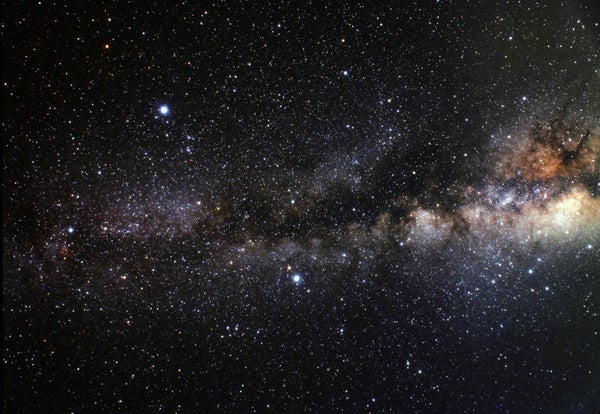A lone bright star now hangs low in the south during early evening. First-magnitude Fomalhaut — often called “the Solitary One” — belongs to the constellation Piscis Austrinus the Southern Fish. From mid-northern latitudes, it climbs 20° above the horizon at its best. How solitary is Fomalhaut? The nearest 1st-magnitude star to it, Achernar at the southern end of Eridanus the River, lies some 40° away.
Saturday, November 18
Although yesterday morning marked the peak of the annual Leonid meteor shower, observers still can see a number of “shooting stars” before dawn. Astronomical conditions should be nearly perfect because the Moon reaches its New phase today and thus remains invisible all night. An observer under a clear, dark sky can expect to spot 5 to 10 Leonid meteors per hour. The meteors appear to radiate from a point in the Sickle asterism of Leo the Lion, a region that rises in late evening and climbs high in the southeast before dawn. Prime viewing occurs between approximately 3 a.m. local time and the start of twilight some two hours later.
New Moon occurs at 6:42 a.m. EST. At its New phase, the Moon crosses the sky with the Sun and so remains hidden in our star’s glare.
Sunday, November 19
The days of viewing Saturn in the evening sky are dwindling rapidly. Still, you can find the ringed world nearly 10° high in the southwest an hour after sunset. The planet shines at magnitude 0.5 and lies on the border between Ophiuchus and Sagittarius. (It crosses from the former constellation into the latter one today.) Although the best views of Saturn through a telescope came earlier in this apparition, it never hurts to take a final look. This week, the planet’s disk measures 15″ across while the ring system spans 35″ and tilts 27° to our line of sight.
Monday, November 20
Look for a two-day-old waxing Moon low in the southwest about 45 minutes after sunset. Although the slim crescent appears only 5 percent lit, its unlit portion should show the faint illumination of earthshine. If you turn binoculars toward the Moon, you’ll also see Saturn 3° to its lower left. Then, scan toward the horizon and you should pick up Mercury 8° directly below Luna.
Head outside a half-hour before sunrise and you’ll find Jupiter blazing low in the east-southeast. The giant planet glows at magnitude –1.7 and stands out against the twilight. If you look 8° to Jupiter’s lower left, you should see magnitude –3.9 Venus gleaming just 5° above the horizon. The two planets were in conjunction last week, but they are now pulling away from each other. While Jupiter climbs higher and appears more prominent with each passing day, Venus dips closer to the Sun’s glare and soon will disappear.
The Moon reaches apogee, the farthest point in its orbit around Earth, at 1:53 p.m. EST. It then lies 252,358 miles (406,132 kilometers) from Earth’s center.
Wednesday, November 22
Neptune’s westward motion against the background stars comes to a halt today. The distant planet appears highest in the south around the end of evening twilight and sets around midnight. The magnitude 7.9 world lies in Aquarius, 0.6° south of the 4th-magnitude star Lambda (λ) Aquarii. You’ll need binoculars to spy Neptune and a telescope to see its blue-gray disk, which spans 2.3″.
Thursday, November 23
After the Sun sets this evening, look low in the southwest for Mercury. For observers at 35° north latitude, the innermost planet lies 7° above the horizon 30 minutes after sunset. (It appears somewhat higher the farther south you live.) Binoculars will help you to find the magnitude –0.4 object in the twilight glow. Today marks the peak of Mercury’s evening apparition because it reaches its maximum elongation from the Sun (22°).
Friday, November 24
Although Thanksgiving weekend signifies autumn to many people, the stars of both summer and winter appear prominent in late November’s evening sky. If you head out around 9 p.m. local time and look toward the west, you’ll see the bright stars of the Summer Triangle. These three luminaries — Vega, Deneb, and Altair — stand out nicely. Deneb appears highest (nearly halfway to the zenith), while the brightest, Vega, lies farthest to the north. Now, if you turn around and face east, you’ll find stars normally associated with winter. Betelgeuse, Rigel, Aldebaran, and Capella all clear the horizon before 8 p.m. and appear conspicuous an hour later.
The variable star Algol in Perseus reaches minimum brightness at 3:49 a.m. EST tomorrow morning. If you start watching it late this evening, you can see its brightness diminish by 70 percent over the course of about five hours as its magnitude drops from 2.1 to 3.4. This eclipsing binary star runs through a cycle from minimum to maximum and back every 2.87 days. Algol appears nearly overhead around 11 p.m. local time and remains well above the northwestern horizon until dawn.
While the stars of summer and winter remain on view these late November evenings, the stars of spring are not so lucky. The Big Dipper swings low in the north at this time of year. Although this conspicuous asterism never sets from much of the United States and Canada, it does come close. And the star at the end of the handle — magnitude 1.9 Eta (η) Ursae Majoris — does dip below the horizon around 9 p.m. local time for viewers south of 40° north latitude.
Mars stands out in the eastern sky before dawn this week. The magnitude 1.7 Red Planet rises more than three hours before the Sun and appears 20° high as twilight starts to paint the sky. It resides among the background stars of Virgo, and this morning it appears 4° above the Maiden’s brightest star, 1st-magnitude Spica. Unfortunately, the view through a telescope proves disappointing — Mars spans just 4″ and shows no detail.
Sunday, November 26
First Quarter Moon occurs at 12:03 p.m. EST. As darkness descends across the Northern Hemisphere this evening, observers will find the half-lit Moon due south and nearly halfway from the horizon to the zenith. Our satellite spends the night in the constellation Aquarius the Water-bearer.












